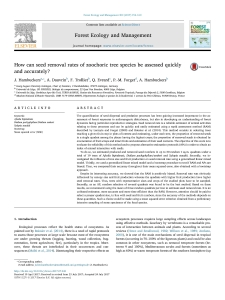Hambuckers J., Dauvrin A., Trolliet F., Evrard Q., Forget P.M., Hambuckers A.
The quantification of seed dispersal and predation processes has been gaining increased importance in the assessment of forest responses to anthropogenic disturbance, but also in developing an understanding of forest dynamics facing particular reproductive strategies. Seed removal rate is a reliable estimator of animal activities relating to these processes and can be quickly and easily estimated using a rapid assessment method (RAM) described by Lermyte and Forget (2009) and Boissier et al. (2014). This method consists in selecting trees reaching a given fruit crop in plots of interest and estimating, under each tree, the proportion of removed seeds in a single quadrat among the places having the highest crops; the proportion of removed seeds is obtained by enumeration of fruit scraps and intact fruits and estimation of their seed contents. The objective of this work is to evaluate the reliability of this method and to propose alternative estimation protocols (APs) in order to obtain an index of animal interaction with seeds.
To do so, we estimated produced and removed seed numbers in up to 30 random 1 sq.m. quadrats under a total of 19 trees of Afzelia bipindensis, Dialium pachyphyllum/zenkeri and Xylopia staudtii. Secondly, we investigated the influence of tree size and fruit production on seed removal rate using a generalized linear mixed model. Thirdly, we used a generalized linear mixed model and a bootstrap procedure to test if RAM and APs are biased. Then, we compared their accuracy throughout their mean squared error, also obtained with a bootstrap approach.
Despite its interesting accuracy, we showed that the RAM is positively biased. Removal rate was obviously influenced by canopy size and fruit production whereas the quadrats with higher fruit production have higher seed removal rates. Thus, trees with representative sizes and crops of the studied plots have to be sampled. Secondly, as an AP, random selection of sev ral quadrats was found to be the best method. Based on these results, we recommend using the mean of three random quadrats per tree to estimate seed removal rate. It is an unbiased estimator, more accurate and more time efficient than the RAM. However, attention should be paid to select a proper quadrat size, in line with seed and fruit numbers, since the accuracy of the methods depends on these quantities. Such a choice could be made using a mean squared error criterion obtained from a preliminary intensive sampling of some specimens of the focal species.
Consultez la notice complète sur ORBi

